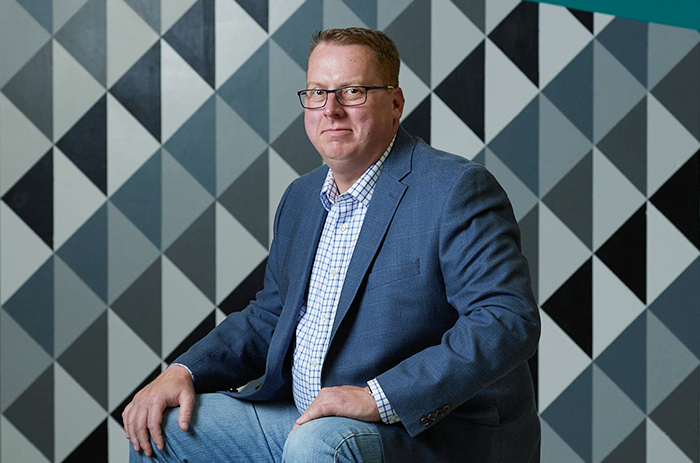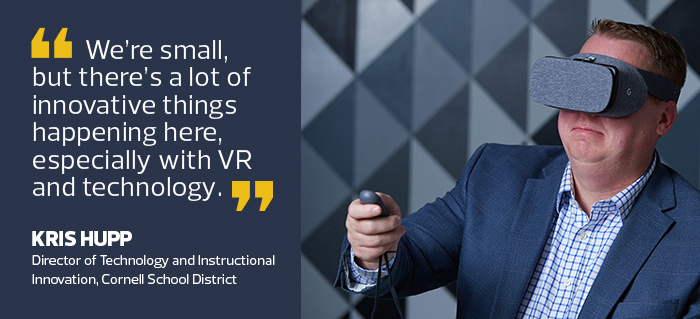Q&A with VR Innovator Kris Hupp on the Best Ways to Bring Tech to Schools
As the director of technology and instructional innovation at a small school district in Pennsylvania, Kris Hupp has a better than average handle on how virtual reality can shake up and shape K–12 education. That’s because Hupp and his colleagues at the Cornell School District outside Pittsburgh worked with experts at Carnegie Mellon University to bring VR to 600 students there, many of whom live in poverty.
With a grant and partnership to support the program, Hupp and the district’s teachers teamed up to help their curious students explore exotic lands and immerse themselves in nature — all without leaving their classrooms.
Hupp spoke with EdTech Managing Editor Jena Passut about the VR program’s past and present and the ways in which other districts might incorporate the emerging technology into their curricula.
EDTECH: Tell us about the latest innovative programs at Cornell.
HUPP: We are one of 50 schools from across the country participating in the Dynamic Learning Project with Google and Digital Promise. We just launched a new computer science program this year. We also just finished renovating our high school with new interactive displays and collaborative furniture.
The teachers in the renovated space all agreed to give up their traditional desks in exchange for mobile standing desks. We also just won a grant to develop an outdoor learning space that will integrate the history of the area with ecological studies and technology. We’re small, but there’s a lot of innovative things happening here, especially with VR and technology.
EDTECH: Why is a school district an ideal place to experiment with VR?
HUPP: Cornell School District is ideal because we’re small and flexible. Our teachers are passionate about teaching and learning and are willing to take risks and experiment. We offer as much professional development as any district in the country. What makes our PD unique is that almost all of it is voluntary. Our teachers have an attitude and willingness to go above and beyond, and they regularly come in early or give up their lunch or prep periods to try to better their craft. We work together to provide our students with the best opportunities possible while also having fun.

VR can be a great tool for encouraging collaboration between students, says Cornell School District Technology Director Kris Hupp. Photo: Karen Meyers.
Our school is well connected and frequently collaborates with other schools, nonprofits and businesses. We are part of a Greater Pennsylvania-based group called Remake Learning that is a network dedicated to transforming teaching and learning. This past spring, our school hosted two national organizations that were in town, the Education Funder Strategy Group and Next Generation Learning Challenges. Both groups were visiting Pittsburgh to learn about our network and how we all work together. Perhaps there’s something in our three rivers?
EDTECH: How did VR first get on your radar as a possible learning tool?
HUPP: Superintendent Aaron Thomas and I wrote a STEAM grant through the Allegheny Intermediate Unit for $20,000, which we won. Our goal was to explore VR and see how we might use it to improve learning. It took us a really long time after we were awarded the money to settle on a device. I worked with a group at Carnegie Mellon University called the CREATE Lab. They are all about empowering the community with robots and technology, and they were exploring VR as well. We ended up purchasing the Google Pixel with the Daydream View headset, which provided a lot of additional opportunities for students.
At the same time, I got in contact with John Balash, the director of educational engagement of CMU’s Entertainment Technology Center, which is separate from the university’s CREATE Lab. The ETC is a graduate program that marries CMU’s fine arts program and their computer science program. Graduates from there go on to work at Disney or elsewhere, designing theme parks, rides, video games and more.
The graduate students wanted to do VR where the user could interact with other people in a virtual space, which is very unique, especially for the Google Pixel. They were interested in working with middle school students at our school in science or social studies, and they wanted to do something related to what the teachers were already teaching in the classroom. I really liked this project because they asked for the teachers’ input, and that really made it about student learning. After meeting with our teachers, they decided to work on biomes.
EDTECH: How are you using VR to make a more meaningful learning experience for students?
HUPP: When they went through Project Voyage at CMU, the students were able to explore a virtual environment and see white tail deer, for example, and get information on that and other things in the biome. Ultimately, they ended up on a scavenger hunt, using what they had learned through the VR experience. They were in competition with their classmates, and they worked in teams, which was fun. It was mind-blowing that they were all in the same virtual space.

For students to be able to step out of their classrooms for a moment and be in Madrid or looking at the Great Pyramid, it’s really a neat opportunity. After all, we can’t just throw them on a jet and send them there. I think it makes learning authentic. Even though it’s virtual, it’s a lot closer to the real thing than reading a paragraph on what something might look like, or even looking at a photograph.
One of the other cool things that we did when we first got the equipment was have the students watch the presidential inauguration through VR. They could watch the president speaking and then turn around and look at the crowds.
It was a historical event, and they got to experience it in a really new way using technology, so I would expect those kids to remember that for a very long time.
EDTECH: What advice do you have for school district officials who may want to invest in VR?
HUPP: Start small. I think it was good that we had a limited budget. It wasn’t a tiny budget, but we couldn’t just go buy everything. That made us extremely careful about what we purchased. We did a lot of research, and continue to do a lot of research. Certainly, there’s a lot of data being gathered about how long kids should use VR equipment, so stay informed about that.
Also, make sure you have a strong wireless network to support a VR program. And always think of how it will benefit the kids first. If it isn’t an amazing learning experience for your students, find something else that is.









